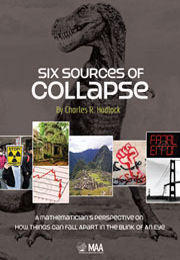 Six Sources of Collapse
Six Sources of Collapse The world is a fascinating combination of fragility and resilience. In the midst of terrible wars and atrocities and countries being torn apart, we also see images of children playing soccer in the street and young couples starting futures together at wedding celebrations. The signs of past collapses are all around us, but we keep building new lives, structures, and institutions to take their place.
This is a book about collapse. It's intended to help some of us manage collapse a little better, promoting it when we want to and protecting ourselves from it when we need to. The first step is to understand it better, using different tools and different points of view. Much of this book is about history and experience — the anatomies of past collapses in many different subject areas from finance to fighter jets, networks to nanostructures. In surveying these diverse cases, we find extraordinary commonalities. The same kinds of dynamics occur over and over again.
Let me explain why my background as a mathematician gives me a particular perspective on this subject. Some people think that math is all about solving equations, but they're dead wrong. Math is much more about identifying common features and describing them in a way that captures their essence. Mathematical symbols and equations are basically a language that helps to clear away some of the detail so we can focus on those fundamental underlying features or principles.
To save this book to your Kindle, first ensure [email protected] is added to your Approved Personal Document E-mail List under your Personal Document Settings on the Manage Your Content and Devices page of your Amazon account. Then enter the ‘name’ part of your Kindle email address below. Find out more about saving to your Kindle.
Note you can select to save to either the @free.kindle.com or @kindle.com variations. ‘@free.kindle.com’ emails are free but can only be saved to your device when it is connected to wi-fi. ‘@kindle.com’ emails can be delivered even when you are not connected to wi-fi, but note that service fees apply.
Find out more about the Kindle Personal Document Service.
To save content items to your account, please confirm that you agree to abide by our usage policies. If this is the first time you use this feature, you will be asked to authorise Cambridge Core to connect with your account. Find out more about saving content to Dropbox.
To save content items to your account, please confirm that you agree to abide by our usage policies. If this is the first time you use this feature, you will be asked to authorise Cambridge Core to connect with your account. Find out more about saving content to Google Drive.